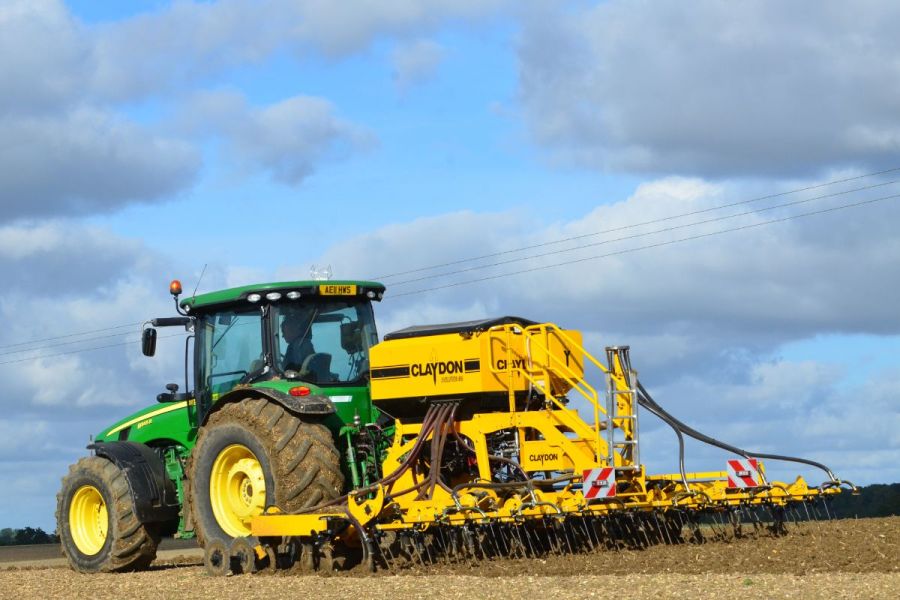Is any piece of machinery more innovative than the drill? As manufacturers persevere to perfect the key tools in crop establishment, a raft of new machines have hit the market. CPM gets the lowdown from manufacturers.
By Melanie Jenkins
The past year has seen a raft of new drills hit the market, from those best suited for direct drilling situations to those capable of navigating heavier inversion systems. Here are some of the latest products from manufacturers.
Amazone
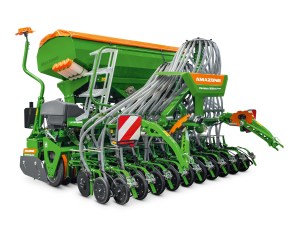
The key feature of Amazone’s Centaya-C pneumatic harrow-mounted drill is its 2000-litre twin chamber hopper.
Aimed at tackling the challenges of crop establishment and providing a modern seeding system to help growers in their quest to achieve the highest yield, Amazone has extended its range of pneumatic harrow-mounted seed drills with its new Centaya-C.
Released in 2022, the key to this new ISOBUS controlled addition is its 2000-litre twin chamber hopper, which allows growers to apply several materials in one pass. This feature has been added to address the increasing focus on dual applications, either of more than one seed type or for a seed and fertiliser split.
According to Amazone, the new 2000-litre twin-chamber hopper on the Centaya-C allows the machine to sow companion crops or for under-sowing in addition to the main cash crop. The firm states that this can provide benefits in terms of weed suppression, as well as aiding biodiversity and giving users more ability to manage erosion.
The ability to use different sowing techniques allows farmers and contractors to make the most of different agronomical methods and provides more flexibility, as well as the potential for fuel and time saving, claims Amazone.
Available in working widths of 3m, 3.5m and 4m, the Centaya-C can be equipped with two different disc sizes, either the RoTeC pro single disc or the TwinTeC double disc coulters.
If fitted with the 400mm RoTeC pro, two types of media can be applied using the single chute. Both materials are metered individually but are fed into a single entry point. This means that a small amount of fertiliser can be placed in the row with the seed.
Using the TwinTec coulter, two different seed types or both seed and fertiliser can be applied to separate entry points. With either, the first material is placed with the TwinTec coulter and the second is embedded via a separate conveyor on the coulter in front of the depth guidance roller.
The Cetaya-C Super can also be used with Amazone’s GreenDrill 200 catch crop seeder box, allowing for a third material to be applied to the surface behind the drill using baffle plates.
Electric metering units permit sowing rates of 0.5-400kg/ha at forward speeds of up to 12km/h with row spacings of 12.5cm and 15cm. The hopper can be split 60:40 or 70:30 and seed rate can be adjusted from the cap during the task.
Depending on the soil conditions, the drill can be combined with the KE 02 rotary harrow or the KG and KX rotary cultivators. On very light soils, the Centaya-C Super can be used with the compact disc harrow CombiDisc.
Claydon
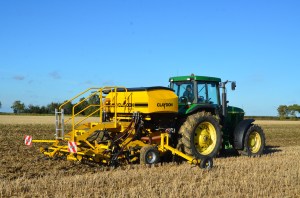
All Claydon Evolution models feature a hydraulic fan, Artemis metering control and tramlining facility.
Launched last year, Claydon’s new range of mounted Evolution direct drills can also be used after consolidation in ploughing and min-till scenarios.
With working widths of 3m, 4m, 4.5m, 4.8m, 5m and 6m, the Evolution models incorporate nine, 13, 15 or 19 tines, respectively. Most models feature a 1910-litre hopper, but the 3m Evolution 3MF and 4m 4MRF models incorporate a 2700-litre tank with a 50:50 split between seed and fertiliser. Second and third hopper options allow for the application of multiple types, varieties and sizes of seed.
All Claydon Evolution models feature a hydraulic fan, Artemis metering control and tramlining facility. Typical daily outputs range from 20ha for the 3m Evolution, which requires a minimum of 150hp, to 40ha for the 6m version, which calls for a minimum of 300hp.
Hydraulically controlled seed depth adjustment is a new feature of the range, as well as improved metering unit access. Other features include quick-fit knock-on/knock-off coulter options for the standard leading tine and A-Share to low disturbance twin disc and tine options.
Further options include GPS variable seed rate capability, pre-emergence marker arms, front disc toolbar, stone protection, micro fertiliser applicator, low-disturbance twin tine kit, slug pelleter, blockage sensors as well as a light and vision kit.
Horsch
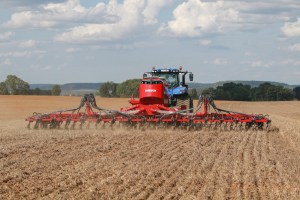
The new Sprinter SL and SC are compact versions of Horsch’s large-scale Sprinter NT drill.
Back in December, Horsch announced that it was adding 8m, 9m and 10m working width models to its Avatar SD range of direct drills. Just like the 12m Avatar 12.25 SD launched in 2021, the new models feature 25cm row spacings. The 8m model is also available with 16.7cm row spacings.
“The 25cm row spacing is proving popular with the 12m model. Customers are reporting little to no detriment in yield in most crops, particularly in winter crops, yet lower input costs. The new models offer these benefits to customers wanting a smaller working width,” highlights Stephen Burcham of Horsch UK.
New to the extended model range is a triple tank system with a 6400-litre capacity which can be split 60:10:30. A double 60:40 split tank option is also available.
To help remove organic material, stones and clods from the rows, an optional trash wheel can be mounted in front of the single disc seed coulters. Where there are high levels of organic material, this can help reduce the hair pinning effect.
Horsch has also compacted the features of its large-scale Sprinter NT drill in its new SL and SC models. The trailed 12m Sprinter 12.25 SC and mounted 6m Sprinter 6.25 SL drills feature 25cm row spacing and can be folded to the 3m transport width required for movement on UK roads.
Both drills come with different seed coulter options, including the Ultra ThinEdge that provides a 12mm wide seed band to ensure minimum of soil movement, the ThinEdge coulter with a 21mm seed band (suited for sowing catch crops directly into the stubble) and the WideEdge tine seed coulter which has a 110mm seed band.
Equipped with a 6300-litre double hopper which is based on the design of the Avatar 8.25, the SL and SC drills should soon be available with a triple tank or MiniDrill option.
The tines of the Sprinter 12.25 SC are hydraulically pre-stressed, with a coulter pressure up to 180kg, and can be retracted for transport. The tines are individually depth-controlled with a press wheel and the three-bar tine section.
Kuhn
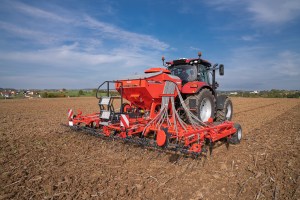
Kuhn’s new Megant 602R drill is lightweight allowing for it to be operated by tractors with as little as 150hp.
Announced in the latter stages of 2022, Kuhn’s new Megant 602R drill is lightweight, allowing for it to be operated by tractors with as little as 150hp.
The latest 6m model has had a number of new features added compared with the previous 600 version, including updated tine coulters and terminal. It also includes half-width shut off and the option to add a second 110-litre SH 1120 hopper – allowing two crops to be drilled in a single pass.
The Megant has the option of three types of tines, including reversible forward action, straight, and a new narrow 12mm straight tine coulter. Kuhn claims the latter can reduce soil displacement through improved penetration and can minimise wear on the tine due to the addition of carbide-plated points.
A new 1800-litre hopper – capable of holding 1200kg of wheat and able to drill 60ha a day – has been welded and included internal steps, replacing the riveted hopper of the previous model. A shut off door allows operators to isolate the two compartments, meaning the metering unit can be adjusted when the hopper is full and prevents seed settling while the drill is in transit.
The drill’s new VT 30 terminal means it is suitable for tractors with and without ISOBUS. The terminal features shock-proof casing and larger buttons for ease of use and is compatible with both Kuhn CC1 800-1200 and other ISOBUS terminals.
Fitted with Kuhn’ Vistaflow valves – which can be configured and controlled from the terminal – operators can programme the flow of seed and save settings for future use. Tramlining configurations can also be recorded, including working width and wheel track, to help with the line-up of sprayer and fertiliser applications.
Several features from Kuhn’s larger Espro drill have been leant to the Megant, including spring-loaded nonstop track eradicators and side markers that are better suited to dry conditions.
Lemken
Lemken launched its new Solitair DT drill last autumn with one 6m machine it was able to use last year in the UK, says the firm’s Paul Creasy.
“The unique feature is the pre-running wavy disc that runs in front of the drilling disc coulter,” he says. “This enables the machine to be used in low disturbance situations where bad blackgrass is an issue, for example.
“And although we don’t sell it as a direct drill, with our OptiDisc H coulter bar this machine is well able to run in low till systems and drill into green cover crops too.”
Väderstad
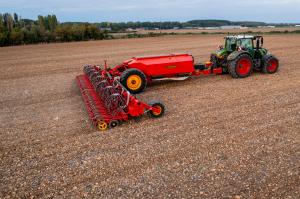
Väderstad’s Inspire is a new 12m, high-capacity precision seed drill with a responsive double disc seed coulter system.
Väderstad has two new innovations to introduce to the market. The first of which is its new 12m, high-capacity precision seed drill with responsive double disc seed coulter system – the Inspire, which is now available in the UK for the 2023 season.
Offered in two different models – the 1200S and 1200C – the S is a seed only version which is equipped with a 5000-litre seed hopper. The C is a combi version which includes a 7200-litre hopper holding both seed and fertiliser in two separate compartments, which is later mixed into the same airstream and placed together into the soil.
Eight separate sections – each with a Fenix III metering unit – allow for high output and variable rate application and section control – down to 1.5m sections.
Both the S and C models have a double disc seed coulter system to help them adapt to field irregularities, meaning a constant seed depth and accurate seed placement should be maintained, says the firm.
Drilling is controlled via the iPad-based management system Väderstad E-Control, which can also connect to an ISOBUS task control system.
In addition to the Inspire, Väderstad’s new Proceed concept drill is targeted at advancing seeding technology. The firm attests that the concept machine could be capable of increasing the yield potential of a full range of crops, including wheat, barley, oilseed rape, sugar beet, peas, maize and sunflower.
“How to farm profitably and sustainably now and in the future is getting complicated,” says Andy Gamble of Väderstad. “Production costs are increasing while prices paid for crops are not, and new regulations, along with a shift in subsidies and the need for environmental care puts farmers in exposed positions.
“But modern farming is not looking for quick fixes. It needs sustainable long-term solutions that accomplish more with less. Väderstad sees the Proceed drill as one of the solutions to help farmers face the future with confidence,” says Andy.
“The Proceed places the smallest of seed at the ideal depth with millimetre precision, leading to yield increases as well as less need for tillage, chemical treatment and use of fertilisers,” he claims.
At the heart of the drill is its high-precision row units. Prior to seed placement, individual pre-drilling wheels consolidate the field to ensure the same conditions for each seed. The pre-drilling wheels are individually mounted, using hydraulic downforce to deliver high performance.
When the seeds reach the row units from the central hopper, an adapted version of the Väderstad PowerShoot singulation system takes full control of each single seed all the way down to the soil. Each seed is received by a stop wheel, which is designed to optimise seed-to-soil contact at the selected depth across the full working width of the machine.
To provide the driver with full control, each row unit is electrically driven and controlled via Väderstad E-Control. Functions include row-by-row shut-off and variable rate, dynamic tramlining, individual calibration, as well as real-time precision monitoring and control.
According to the firm, field trials have demonstrated that the Proceed can reduce wheat seed rate by up to 50% without compromising yield when compared with modern seed drills.
In the trials, a few months after drilling winter wheat at a seed rate of 150 seeds/m², plant biomass was recorded as having an increase of 102% – 72% in root biomass and 62% more shoots per plant – compared with a modern seed drill, claims the firm.
The Proceed has a row spacing of either 225mm or 250mm and simple calibration. A quick change of seed discs allows the drill to switch to 450mm or 500mm for crops such as sugar beet or OSR, and to 750mm for crops like maize or sunflower.
This article was taken from the latest issue of CPM. For more articles like this, subscribe here.
Sign up for Crop Production Magazine’s FREE e-newsletter here.

